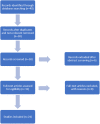Union rates and functional outcome of double plating of the femur: systematic review of the literature
- PMID: 33484313
- PMCID: PMC9110521
- DOI: 10.1007/s00402-021-03767-6
Union rates and functional outcome of double plating of the femur: systematic review of the literature
Abstract
Background: The optimal treatment strategy for the surgical management of femur fractures and non-unions remains unknown. The aim of this study is to assess union rates, complications and outcome after femoral double plating. Treatment of shaft, distal, periprosthetic fractures and pathological proximal femur fractures as well as femoral non-unions with double plating were evaluated.
Methods: A systematic review according to the Preferred Reporting Items for Systematic reviews and Meta-Analyses (PRISMA) statement was conducted. Published literature reporting on the treatment and clinical outcome of femoral fractures and non-unions with double plating was identified. In total, 24 studies with 436 cases of double plating, 64 cases of single plating, 84 cases of intramedullary nailing (IM), and 1 interfragmentary screw treatment met the inclusion criteria of this systematic review. The evaluated literature was published between 1991 and 2020.
Results: Double plating of femoral fractures achieved high healing rates and few complications were reported. It displayed significantly less intraoperative haemorrhage, shorter surgery time reduced risk of malunion in polytraumatised patients when compared to IM. Fracture healing rate of double-plating distal femoral fractures was 88.0%. However, there were no significant differences regarding fracture healing, complication or functional outcome when compared to single plating. Treatment of periprosthetic fractures with double plating displayed high healing rates (88.5%). Double plating of non-unions achieved excellent osseous union rates (98.5%).
Conclusions: The literature provides evidence for superior outcomes when using double plating in distal femoral fractures, periprosthetic fractures and femoral non-unions. Some evidence suggests that the use of double plating of femoral fractures in polytraumatised patients may be beneficial over other types of fracture fixation.
Level of evidence: IV.
Keywords: Double plating; Femoral fractures; Non-union; Periprosthetic fracture; Polytrauma.
© 2021. The Author(s).
Conflict of interest statement
The authors declare that they have no known competing financial interests, non-financial interests or personal relationships that could have appeared to influence the work reported in this paper. The authors did not receive support from any organisation for the submitted work. No funding was received to assist with the preparation of this manuscript. No funding was received for conducting this study. No funds, grants, or other support was received. The authors have no relevant financial or non-financial interests to disclose. The authors have no conflicts of interest to declare that are relevant to the content of this article. All the authors certify that they have no affiliations with or involvement in any organisation or entity with any financial interest or non-financial interest in the subject matter or materials discussed in this manuscript. The authors have no financial or proprietary interests in any material discussed in this article.
Figures
References
Publication types
MeSH terms
LinkOut - more resources
Full Text Sources
Other Literature Sources
Medical
Research Materials
Miscellaneous


